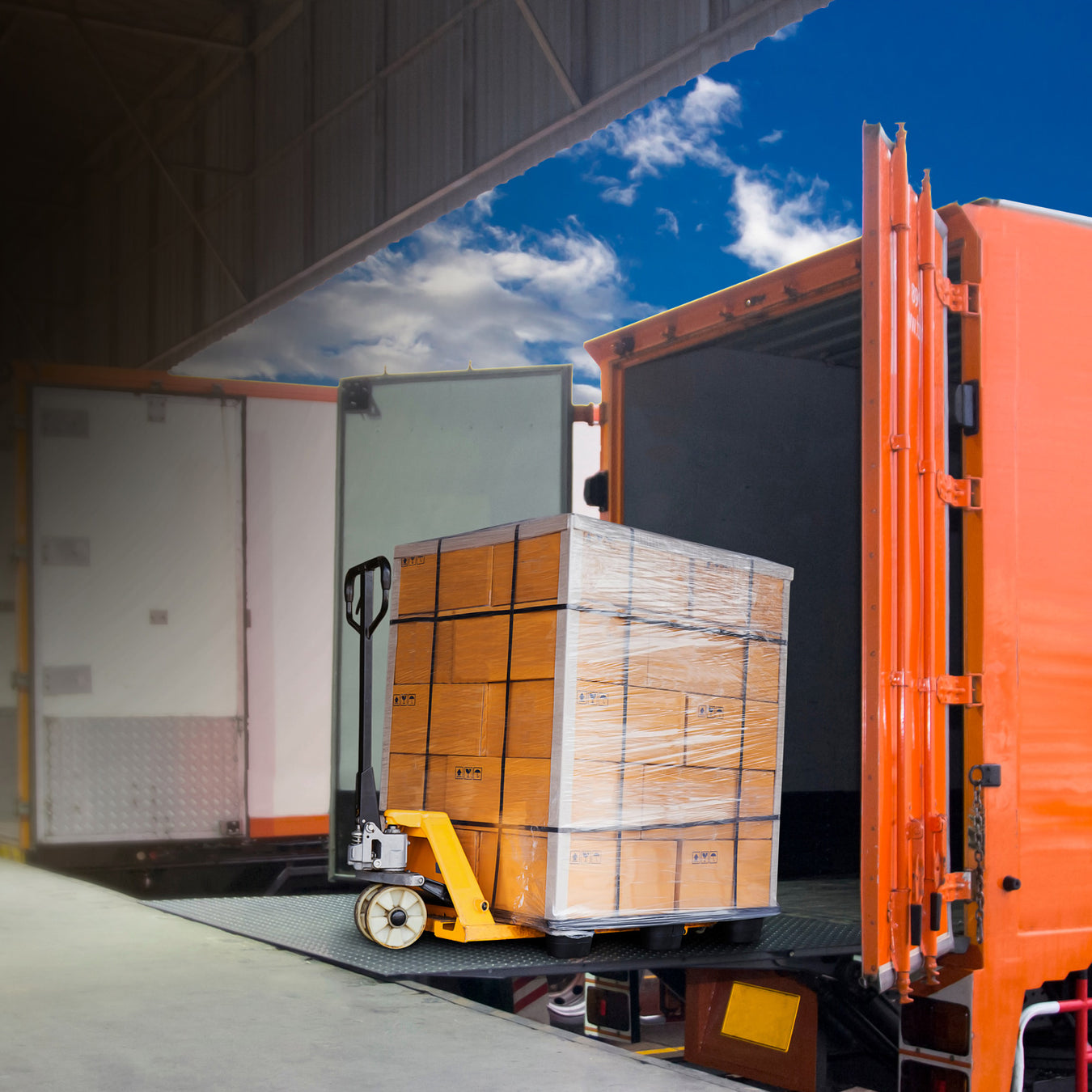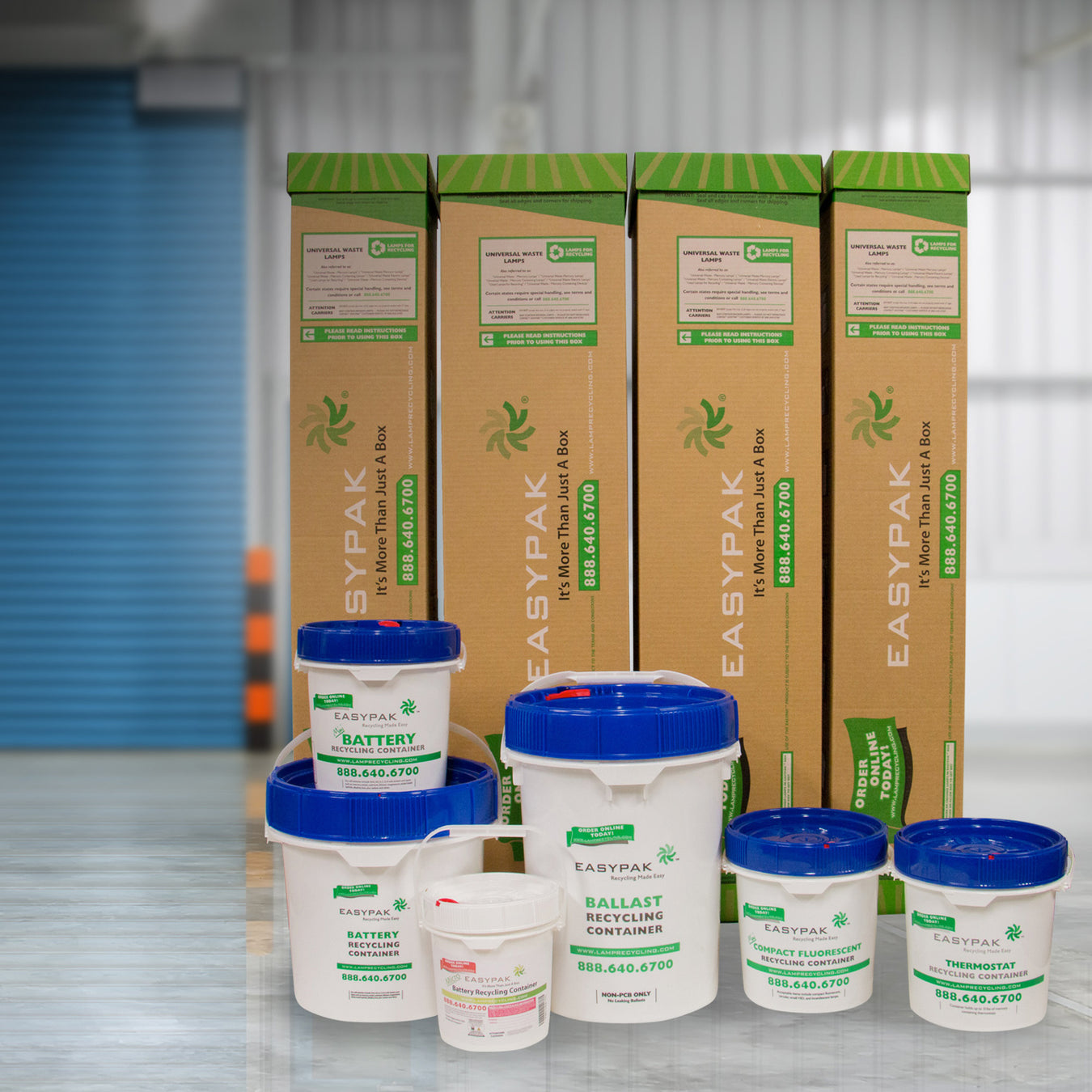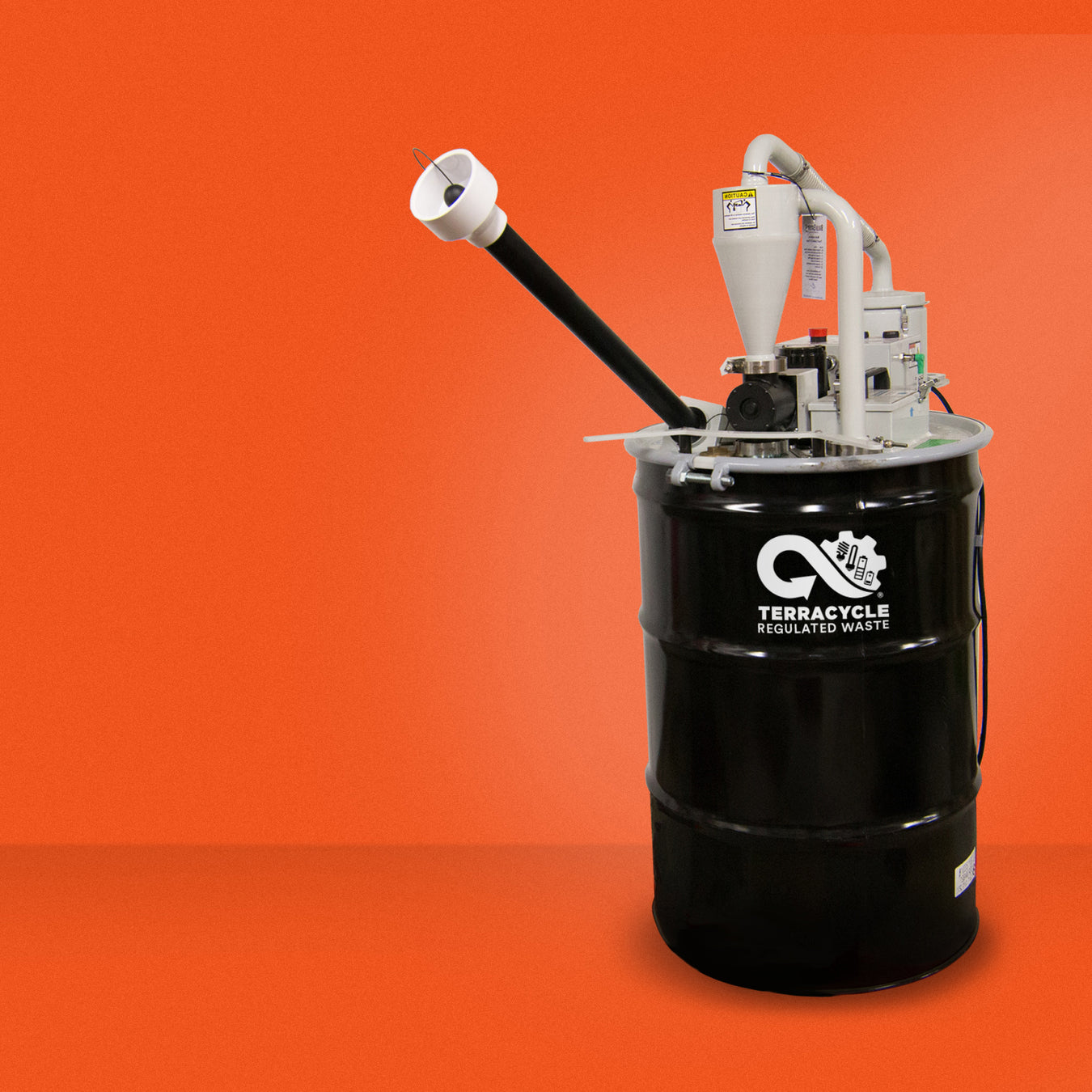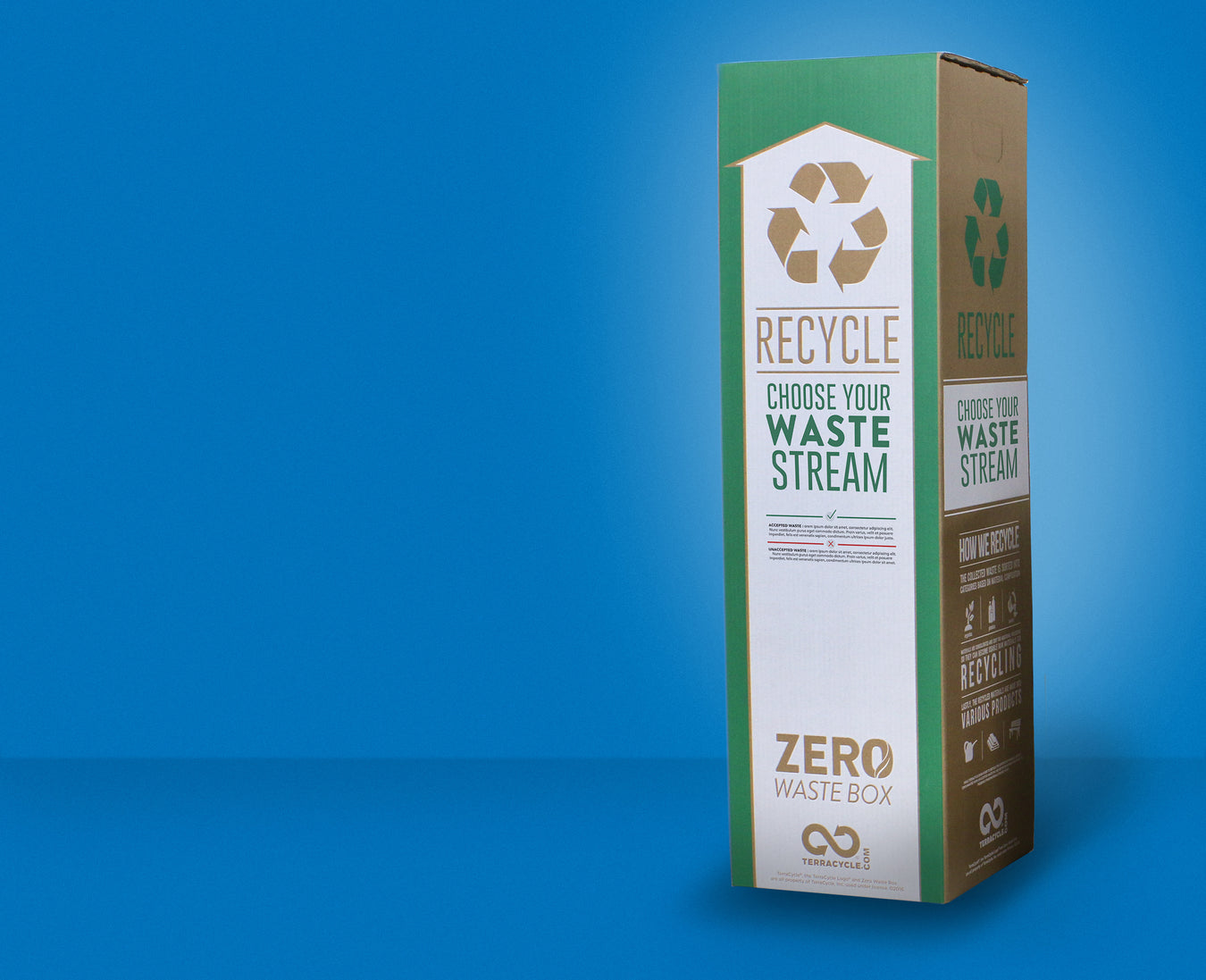
We understand that you probably have a number of questions that you would like to ask us. If you can't find what you're looking for below, please feel free to contact us or talk to a representative at 800-909-9709. We will do our best to answer any questions you may have, as well as provide you with resources you need.
What if I only have small amounts of materials to recycle?
No problem. TCRW and CRS can provide a recycling solution for any customer. Please visit our prepaid recycling page to find the best solution to meet your needs. Our EasyPaks and ZWBs are small containers that can be shipped directly to you and once filled, shipped back to us for processing. The cost includes the container, shipping fees to you and back to TCRW/CRS, recycling the materials and containers, and a certificate of recycling.
How can I learn about the regulations in my state?
Many states’ regulations vary frequently. Please visit www.lamprecycle.org for an update on your state’s lamp recycling regulations. You may also access their website under our useful links section on our State Regulations page.
Can I throw mercury lamps into the trash?
Fluorescent and HID lamps contain mercury which is toxic and harmful. Federal regulations require that spent hazardous waste lamps be managed properly by certified organizations like TCRW and CRS; most states allow lamps to be managed as “Universal Waste”, providing that they are recycled. If lamps are not recycled, they must be managed as hazardous waste. Learn about how we handle fluorescent and HID lamps by contacting us today.
What about “green end” lamps or TCLP compliant lamps?
Low mercury bulbs are lamps that pass the TCLP test for mercury, meaning that if they were broken/crushed in a landfill, the mercury that leaches into the environment would be below the permissible levels. The lamps still contain mercury and most state agencies and manufacturers do recommend recycling for handling. We make disposing of low mercury bulbs quick and easy.
How do I choose the right recycler for my lamps?
Choosing the proper recycler is not always easy when it comes to mercury, but TCRW and CRS can apply our decades of lamp recycling experience to customize a solution to meet your needs. To give you confidence that you are dealing with a company that is going to properly handle the materials you can rest assured that we process materials with in-house mercury distillation capabilities, and we will provide you with a certificate of recycling ensuring all lamps have been processed properly according to local regulations. TCRW and CRS are absolutely the right partner to help with your universal waste management.
What Service Should I Use?
EasyPak™ Pre-Paid Recycling Containers
< 150K Square Feet
EasyPak™
Bulb Eater® On-Site Lamp Crusher
> 150K Square Feet
Bulb Eater®
Nationwide Bulk Pick-ups
> 150K Square Feet
Recycling services and transportation available throughout the continental United States to help facilities properly recycle lamps, ballasts, batteries, and electronics. These wastes are palletized and shrink wrapped prior to pick-up.
Great for properties with large quantities of waste and enough available storage space for at least one pallet to be stored.
Bulk Pickup
What is a Bulb Eater®?
A Bulb Eater® is a lamp crushing machine that processes, or crushes, spent fluorescent lamps into small fragments. The crushed glass is compacted into 55-gallon containers. The Bulb Eater 3 and Bulb Eater 3L crush linear, compact and u-shaped fluorescent lamp. The full drum capacity is up to 1,350 T8 4’ fluorescent lamps. This greatly improves storage of the lamps, handling, safety/liability issues, and fluorescent bulb recycling costs. The units are complete with filtration systems to help ensure both OSHA and EPA compliance, even for facilities disposing of large quantities of lamps.
Why Do People Use The Bulb Eater® System?
Facilities around the world use the Bulb Eater® lamp crushing systems to make their lamp disposal process more efficient. The systems will greatly reduce storage needs, minimize handling of the lamps, create a safer, cleaner work environment, and cut overall fluorescent bulb recycling costs.
How Does The Bulb Eater® Work?
- The lamp is fed into the entry tube of the machine.
- In about one second the lamp, whether straight or U-tube enters the machine and is crushed to pieces.
- The Bulb Eater’s filtration system pulls the contaminated air out of the drum to filter out the released powder as well the mercury vapor.
- The contaminated air goes through a filtering process which captures over 99.9% of the mercury released from the lamp when crushed.
How Long Does It Take To Crush The Lamps?
It takes roughly one second to crush a 4' fluorescent lamp and a fraction of a second longer for 8' lamps.
How Many Crushed Lamps Fit In A 55-Gallon Drum?
1350 Straight T8 4' Lamps / 875 Straight T12 4' Lamps / 475 Straight T12 8' Lamps / 450 U-Shape T12 Lamps
What Does VRS Stand For? VRS-U?
Vapor Removal System AND Vapor Removal System with U-Shape Capability
I've Seen Reference To T8, T12, And T17 Lamps. What Is The Difference?
The diameter of a lamp is measured in eighths of an inch and expressed as a "T" number, such as T8 (equals 8/8's or one inch) and T12 (equals 12/8's or an inch and a half diameter). T17 lamps, while uncommon, are 17/8's or 2 and an eighth inches in diameter. This designation is given in lamp catalogs and sometimes printed on the lamp itself. For example, one of the most common 4' lamps is an F40T12/CW. The Bulb Eater® systems come standard with an entry tube fitted for T12 lamps. T8 and T17 entry tubes are also available.
Is It Safe?
Yes. In fact, studies show that it is actually safer to package lamps by using Bulb Eater® lamp crushing systems than boxing the lamps intact. This is because the Bulb Eater® captures over 99.99% of the mercury vapor released during crushing. While there is a small amount of mercury vapor released, the overall mercury exposure is significantly less than when managing the same quantity of lamps intact and dealing with the accidental breakage of the lamps. No one intends to break the lamps while handling them, but unfortunately when handling tubes of glass up to 8' long accidental breakage is unavoidable. Based on EPA studies that show an accidental breakage rate of 3% (which based on our industry knowledge we believe to be low), our customers are considerably safer crushing their lamps with our controlled emissions systems.
Due to the potential for mercury vapor exposure, our emissions-controlled lamp crushing machines have been tested for OSHA safety compliance by outside testing laboratories (test results available). These tests show that the operator experiences well under both Federal and State OSHA mercury vapor exposure levels. In fact, our most recent emission study showed non-detectable levels of mercury vapor emissions even after crushing 1500 lamps! Also, please note that the State of Illinois Environmental Protection Agency has inspected TCRW's facility and the Bulb Eater® machines. In fact, the State of Illinois Environmental Protection Agency uses the Bulb Eater® to safely package their lamps prior to recycling.
Sure, It Makes Sense To Crush The Lamps, But What Do I Do With The Crushed Lamps?
Contact TerraCycle Regulated Waste to have the drums picked up and transported to one of our contracted recycling facilities to be recycled. This is the preferred method of the EPA and is the most cost efficient option. Depending on your state regulations, you may be able to exclude this waste from your hazardous waste totals. Contact TerraCycle Regulated Waste today for a customized fluorescent bulb recycling quote!
How Often Do The Filters Need To Be Changed?
The filters need to be replaced on a scheduled basis. The first Stage Cartridge filter is changed every 3 full drums. The second Stage HEPA filter is changed at least every 10 full drums. When changed, the filters can be placed on top of the crushed glass inside the drum (depending on applicable regulations). The filters are sent for recycling with the crushed lamps in the drum. The 3rd Stage Premium-Grade activated carbon filter is rated for over a million lamps. Based on these figures, most facilities will never need to change this filter. Should this activated carbon filter become saturated, the filter can be recycled.
Where Do I Buy Extra Filters?
Filters can be purchased online or by calling 800-909-9709.
What is EasyPak™?
EasyPak™ is a pre-paid recycling program for lamps, ballasts, batteries, electronics and Personal Protective Equipment (PPE). One price includes a container, shipping to the recycling center, recycling costs and a certificate of recycling.
Place your order online, or over the phone by calling toll-free 800-909-9709.
Why Choose EasyPak™ Over The Alternatives?
Aren’t all pre-paid container programs the same? No! TCRW’s Vaporshield® technology incorporated in our EasyPak™ boxes for linear fluorescent lamps eliminates the need for a bag and allows for return service through UPS.
EasyPak™ offers the latest in recycling technology and innovative features. In addition to the essentials – a quality product, a fair price, and great customer service. Every EasyPak™ customer has access to the following online features:
- Automatic Re-ordering - Return a full container for recycling, and a replacement container will automatically be shipped to you.
- Certificates of Recycling - Access certificates of recycling from your personal account 24/7. Stay in compliance at all times.
- Container Tracking - Perfect for multiple facilities, container tracking gives managers the ability to quickly determine container status.
How Many Containers Should I Order?
It depends on the amount of waste you generate. It usually helps to order one more container than you need, that way you'll always have one on-site while the other is being shipped back. Each container has a waste limit specified in the product details section.
How Long Will It Take To Receive My EasyPak™ Container?
Typically, all containers are shipped within 3 to 5 business days.
Depending on your distance from our distribution center, you should receive your container(s) in 5 to 8 days.
Can I Place Broken Lamps In An EasyPak™ Container?
EasyPak™ containers are intended for the transport, and recycling of intact fluorescent lamps. However, in the event that a lamp breaks in the container or in transit, our recyclers will still accept it for processing.
Can I Put UV Lamps In An EasyPak™ Container?
You may recycle UV lamps only if it contains solid mercury amalgam.
If you are unsure of the type of mercury inside the lamps, please do not ship it in the EasyPak™ container. Failure to comply will put your company at risk and violate our terms and conditions.
Can I Put Lead Acid Batteries In The EasyPak™ Battery Recycling Container?
Only non-spillable lead acid batteries are accepted in EasyPak™.
Various types of dry cell batteries include alkaline, nickel, cadmium, nickel metal hydride, iron, zinc carbon, and silver, as well as AA, AAA, C, D, and 9-volt.
Are EasyPak™ Container Safe For Transport?
Yes. EasyPak™ containers have been tested and UN Certified at Advanced Packaging Technology Laboratories, Inc., an independent testing laboratory.
Containers are deemed compliant with applicable sections of 49 CFR pertaining to the safe transport of dangerous goods - Packaging Group III. EasyPak™ lamp recycling boxes have been subjected to repetitive shock vibration tests, stacking tests, free fall drop tests, and water absorption tests.
Why Can't I Use My Existing Box To Return My Waste?
Packaging and labeling requirements vary by state, and standard boxes are often not suitable for shipping Universal Waste.
In addition, our transportation partners require the contents be shipped following specific guidelines which require additional containment such as VaporShield®. Shipping with UN and transporter approved EasyPak containers provide compliance with shipping regulations and minimize risk and liability for you.
Where Can I View EasyPak™ Terms And Conditions?
Click for Terms And Conditions
Is EasyPak™ Available In All States?
While EasyPak™ is available in most states nationwide, it is currently not available in Alaska, Hawaii, Maine or Puerto Rico. If you have questions regarding EasyPak™ service and your state regulations, please visit our regulations page , or contact an EasyPak™ representative at (800) 909-9709.
I Lost My Prepaid Shipping Label, What Should I Do?
Call (800) 909-9709 to speak with an EasyPak representative. Be prepared to describe the container, its contents and your location.
The Shipper Refuses To Pickup My Package, What Should I Do?
You may be calling the wrong number. Please make sure you are calling our toll-free number at (800) 909-9709. To schedule a pickup online, click here, fill out the pickup information, and click “Schedule Pickup”.
How Long Does It Take To Get My Certificate Of Recycling?
You will typically be able to access your certificate of recycling 1 week after you ship your EasyPak™ container.
How Do I Become An EasyPak™ Distributor?
Contact an EasyPak™ representative for more details by calling (800) 909-9709.
We offer volume discounts and marketing materials that make selling easy. We would be delighted to have you join our growing nationwide network of EasyPak™ distributors!
Are EasyPak™ Containers Recycled After They Have Been Used?
Yes. Once the contents of a container have been processed for recycling, the empty buckets and boxes are recycled. Your entire purchase is 100% recyclable!
Where Are My EasyPak™ Containers Sent For Recycling?
All EasyPak™ containers are processed at permitted recycling facilities located in the Unites States of America. Containers will be shipped to the facility closest to your location.
How Can I Get More Information On The Machines And/Or This Recycling Service?
Contact TerraCycle Regulated Waste today!
Why Can't I Just Throw My Lamps In The Trash?
Lamps contain mercury and in most cases are considered hazardous. The Environmental Protection Agency regulates the management of spent lamps. Most states do not allow hazardous lamps to be disposed in solid waste landfills.
Tell Me More About TerraCycle Regulated Waste's Recycling Program.
TCRW offers a fluorescent bulb recycling program throughout North America for crushed lamps, as well as intact lamps, ballasts, batteries, and computer hardware. We pride ourselves in offering aggressive pricing to our customers. A toll-free number is available for scheduling or questions. All facilities are properly permitted and provide documentation that the recycling was completed within applicable EPA regulations.
What Happens To The Lamps Once They Are Picked Up?
The lamps are transported to a permitted facility to be processed. The lamps are recycled in machines designed to break down the lamp and then separate the glass, metal, and mercury. Once the glass is clean of the mercury it can be reused as well as the metal and mercury. After the lamps are processed, a Certificate of Recycling will be issued for your records to document that your lamps were properly recycled by a permitted facility.
What Happens To The Batteries Once They Are Picked Up?
All waste recycled through TCRW is processed at fully-permitted facilities within the United States. Batteries undergo a process of inspection, sorting, sizing, recovery, and separation of final products.
Do I Have To Count Every Lamp Before They Are Picked Up?
No. Waste from your bulk recycling pickup will be accurately counted by the recycling facility and you will be billed accordingly.
How Should The Waste Be Packaged Prior To Pickup?
Intact Lamps – All lamps must be packaged in a manner to "minimize" breakage. The OEM box is the most popular method of packaging. If the OEM box is not available, fiber drums are a simple alternative. Because they have lids, fiber drums provide a time advantage to boxing and taping. All lamps must be free of foreign material, including tape (on the actual lamp) and paper sleeves.
Crushed Lamps – Crushed lamps must be sealed in a steel 55-gallon drum complete with locking ring and lid. There cannot be any extraneous material such as wire, trash, or liquids in the drum or it will be returned.
Ballast – Non-leaking ballast should be packaged in a 55- gallon steel drum with locking ring and lid. These drums must also be free of any other foreign material. Leaking ballast should be placed in a plastic bag or a similar material to prevent contaminating the non-leaking ballast, and placed in a separate pail or drum.
Batteries – All batteries should be separated and packaged in a manner that will minimize spilling during transport. The most popular container is a 5-gallon pail. 55- gallon drums also work well if the quantity of materials can justify this size. Larger lead acid batteries should be palletized and shrink- wrapped with slip sheets between each row of batteries. Also, all holes must be plugged to reduce the leaking of acid.
Computer – There is no exact way to package computers. The simplest way is to use Gaylord boxes with lids. Because these are not always available, palletizing and shrink- wrapping is the next best alternative. Smaller components can be placed in any kind of box or secondary containment.
Does TCRW Provide Packaging Materials? Boxes? Drums?
TCRW can provide boxes, fiber drums, or steel drums throughout North America.
Why Is Mercury An Environmental Concern?
Mercury is a metallic element that can accumulate in living tissue. In sufficient concentrations, mercury may cause adverse health effects. Sources of mercury in the environment from human activity include coal-burning power plants, batteries, and fluorescent and HID lamps.
Small amounts of mercury are a necessary component in fluorescent and HID lamps, but when a lamp is broken, crushed, or dispensed in a landfill or incinerator, mercury may be released to the air, surface water, or groundwater. Considering this, it is a good policy to keep the mercury in fluorescent and HID lamps out of the solid waste stream by recycling.
How Do I Know If my Waste Is Hazardous?
All generators of waste, except households, are responsible for determining if their waste is hazardous under current state and federal regulations. Hazardous wastes can either be included on specific lists or exhibit hazardous characteristics. This determination can be done by knowledge of the waste or by testing the waste. The Toxicity Characteristic Leaching Procedure (TCLP) is the test used to determine if a waste exhibits a toxicity characteristic. Wastes found to be hazardous are subject to the hazardous waste management regulations.
What Is Hazardous?
Persons who generate wastes are responsible for determining whether their wastes are hazardous. One common method for determining whether a waste is hazardous is the Toxicity Characteristic Leaching Procedure (TCLP) test. The TCLP test is a laboratory test that simulates the potential leaching of hazardous wastes under conditions typically found in municipal solid waste landfills. If the concentration of mercury in water that is passed through a sample of crushed fluorescent lamp fragments exceeds 0.2 mg/liter, the crushed lamp fragments are classified as a hazardous waste. (See test method 1311 in "Test Methods for Evaluating Solid Waste, Physical/ Chemical Methods," EPA Publication SW846 for more information about the TCLP procedures.)
In most cases, standard fluorescent lamps and lamp fragments fail the TCLP test and are considered hazardous wastes. Facilities should treat the spent lamps and lamp fragments as hazardous wastes unless they test the spent lamps and fragments and determine that the wastes are non-hazardous. Facilities should manage the spent lamps as hazardous waste according to applicable federal, state, and local requirements.
New low-mercury lamps have been introduced into the market. While these lamps may pass the TCLP test and be considered non-hazardous, some states - like Minnesota and Vermont - still prohibit persons from disposing of even these non-hazardous lamps in a solid waste landfill. You may want to talk with a State EPA representative to find out how you may handle spent lamps in your state.
Please note that regardless of whether the State in which you are located allows you to dispose of lamps in your dumpster with other non-hazardous trash, the lamps do contain mercury and mercury vapors are released into our environment when you throw lamps in the trash. Typically, the lamps break in the dumpsters, during transportation or in the landfill and release mercury into the air or groundwater. These hazardous releases are a risk to surrounding communities.
Facilities that throw their spent lamps in the trash thinking they are saving money may be mistaken. Throwing spent lamps in the trash may result in the person being held responsible for the cleanup of a remote and costly Superfund site. Because of the potential liability under Superfund, Air Cycle Corporation believes facilities that decide to recycle their spent lamps are making a smart decision that benefits not only the environment but also the bottom line.
What is Universal Waste?
Universal waste is specific hazardous waste streams that facilities can choose to manage in an alternative manner in place of the more complex hazardous waste requirements. These wastes are typically generated by many facilities and are often not properly managed under hazardous waste regulations.
Universal Waste include:
Lamps:
Fluorescent, high intensity discharge (HID), sodium vapor, mercury vapor, neon, and incandescent lamps
Batteries:
Spent dry cell and lead-acid batteries
Pesticides:
certain suspended, canceled, or unused pesticides
Devices containing elemental mercury:
thermostats, switches, thermometers, manometers, barometers, and various medical devices.
Personal Protective Equipment (PPE):
Mask - Dust, flat-fold, isolation, procedural, respirator (including N95)
Disposable Gloves - Latex, nitrile, vinyl and plastic gloves.
Unacceptable items: DO NOT send in fabrics such as cloth gloves or any items that may be considered Hazardous Waste.
Does Quantity Matter?
Yes. RCRA (hazardous waste) requirements differ according to the amounts of hazardous waste generated per month by the facility. There are three main categories of hazardous waste generators:
Conditionally Exempt Small Quantity Generators (CESQG's) are persons who generate 220 lbs. or less of all hazardous wastes combined (not just lamps!). These generators are exempt from most of the hazardous waste regulations, which include transportation, treatment, and disposal requirements. They must not, however, store more than 2200 lbs. of hazardous waste on site at any time and must dispose of their hazardous waste in facilities that are permitted or authorized to accept hazardous or non-hazardous wastes. Many states acknowledge CESQG exemptions for paperwork, but not for disposal. Many states do not allow CESQG to dispose of hazardous waste in a solid waste landfill.
Small Quantity Generators (SQG) are persons who generate 220 to 2200 lbs. of hazardous waste per month. These generators must keep proper records of the waste, report to EPA, and follow accumulation requirements. These generators can store up to 6 months without a storage permit.
Large Quantity Generators (LQG) generate more than 2200 lbs. of hazardous waste per month. These generators are subject to the full hazardous waste management requirements. These generators cannot store hazardous wastes on site for more than 90 days (3 months) without obtaining a storage permit.
There are 2 categories of Universal Waste handlers:
- Small Quantity Handler - Generator who accumulates less than 11,000 lbs. of universal waste (batteries, pesticides, thermostats, or lamps) at any time.
- Large Quantity Handler - Generator who accumulates more than 11,000 lbs. of universal waste (batteries, pesticides, thermostats, or lamps) at any time.
Universal Waste Storage Limits:
Both Small and Large Quantity Generators of Universal Waste can generally store their Universal Waste for one year. (For more information please contact your state Environmental Protection Agency or Air Cycle Corporation.)
How Is Controlled Crushing Regulated?
Controlled crushing of lamps is regulated under both federal and state hazardous and universal waste regulations. The federal universal waste regulations do not authorize on-site crushing of fluorescent lamps but do allow the States to write rules that will permit crushing on-site. The States of Illinois, Florida, Virginia, Tennessee, Texas, Colorado, Maryland and Montana have all passed rules that allow persons to crush lamps on-site under the universal waste regulations. TerraCycle Regulated Waste is working with several States and expects these States to pass rules within the next year, which allow lamp crushing under universal waste rules.
In States that allow crushing and classify crushed lamps as universal wastes, persons can generally store their waste lamps on-site for up to one year, can ship waste lamps off-site with a bill of lading rather than a hazardous waste manifest, and need not include their lamps when calculating their hazardous waste totals.
Under state and federal hazardous waste regulations, controlled crushing (which is what the Bulb Eater® systems do) is considered treatment. The hazardous waste rules typically require a person who treats wastes to obtain a permit. Federal and most state hazardous waste rules, however, exempt from the permit requirement persons who treat their wastes "within a drum, tank, or container." (See 40 CFR 262.34).
TCRW believes The Bulb Eater® systems fall squarely within this exemption and many States have acknowledged in letters to TCRW that the accumulation tank exemption applies to The Bulb Eater® systems. You should be aware, however, that the States of California, Maine, Massachusetts, Connecticut, Rhode Island and Missouri have more narrow exemptions to the permitting requirements. TerraCycle Regulated Waste suggests you contact representatives of those States before proceeding with on-site crushing.
If your State does not allow crushing under its universal waste regulations, then you typically may manage crushing under your state's hazardous waste regulations as a process exempt from the general permitting requirements. Please note that regardless of whether the lamps are managed as universal or hazardous wastes, you must properly dispose of the crushed lamps preferably by shipping the crushed lamps to a permitted recycling facility.
TerraCycle Regulated Waste will continue to work with State lawmakers, the National Electrical Manufacturing Association and the Association of Lighting and Mercury Recyclers to promote legislation, which will authorize persons to crush lamps under universal waste regulations. TerraCycle Regulated Waste and its customers know that persons are able to safely crush their lamps to reduce volume, minimize handling, cut costs, and create a safer work environment by managing their crushed lamps under either universal waste regulations or existing state hazardous waste regulations.
How Do I Get More Information On These Regulations?
Customers are always welcome to contact customer service at TerraCycle Regulated Waste for further information concerning federal and state regulations. TCRW has a database of contact names at both federal and state environmental protection agencies, as well as guidance papers from many states that are available to our customers. We are more than willing to help you learn more about applicable regulations.
Do You Have A Question Not Listed?
If so, please feel free to contact us or talk to a representative at (800)909-9709






